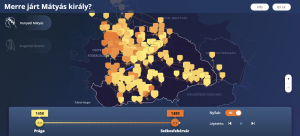Matthias Corvinus or Matthias I (in Hungarian Hunyadi Mátyás) is one of the best known, most iconic and beloved Hungarian King. Born in Kolozsvár/Cluj-Napoca at 23 February 1443, he was the King of Hungary and Croatia from 1458 to 1490.
Matthias Corvinus is also known as the righteous king, many tales and legends describe him as wandering in disguise throughout his realm to deliver justice to his subjects. And now, if you visit Transylvania, you can follow his path. Let’s see how…
On the occasion of the 560th jubilee ofMatthias Corvinus ascending to the Hungarian throne, 2018 was declared a memorial year in Hungary, and in Hungarian communities, such as the Hungarians living in Transylvania. Last year a lot of activities, events were related to the big king, for example this online map, which shows where King Matthias and his wife, Beatrice of Naples traveled during their reign. The map was made in November 2018, but it was found a couple of days ago by the Hungarian news portal, Transindex.
The map was made by the National Archives of Hungary, and it indicates 555 locations which were visited by the King. The initiators of the project  wanted to help the teaching of history in high schools. The initiators declare, in the description part of the website, that a similar map would have been really helpful for them, when learning about the kings campaign, expeditions. They also declare, that knowing the history of the region, city, village where someone lives is a really import part of that person’s identity. Knowing that King Matthias visited someone’s city or village can raise that feeling, and can confirm the identity.
wanted to help the teaching of history in high schools. The initiators declare, in the description part of the website, that a similar map would have been really helpful for them, when learning about the kings campaign, expeditions. They also declare, that knowing the history of the region, city, village where someone lives is a really import part of that person’s identity. Knowing that King Matthias visited someone’s city or village can raise that feeling, and can confirm the identity.
To indentify the locations which were visited by King Matthias the initiators of the program used historical sources, mostly royal diplomas because they include the date and place of the creation of that diploma.
The locations are indicated with shields, the size of the shield shows how many times it was visited by the king. The map also includes the dates of the visits, and the routes of the king.